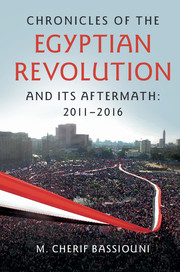Book contents
- Frontmatter
- Dedication
- Contents
- Preface
- Acknowledgments
- List of Abbreviations
- Introduction
- 1 The Early Stage of the Revolution
- 2 Mubarak Relinquishes the Presidency and the SCAF Assumes Power
- 3 A Prelude to Democracy: 2011–2012 Elections
- 4 The Morsi Presidency: June 30, 2012 to July 3, 2013
- 5 The Military's Return to Power and the El-Sisi Presidency
- 6 2015Legislative Elections and the Changing Civilian Political Landscape
- 7 The Military Institution: Its Power, Influence, and Culture
- 8 Violence and Repression
- 9 The Accountability Gap
- 10 The Justice System in Crisis
- 11 The Constitutional Quagmire
- 12 Demographics, Education, and the Economy
- 13 Geopolitical Factors
- 14 Concluding Assessment
- Pictures of the Egyptian Revolution and Related Events
- Bibliography
- Index
Introduction
Published online by Cambridge University Press: 24 November 2016
- Frontmatter
- Dedication
- Contents
- Preface
- Acknowledgments
- List of Abbreviations
- Introduction
- 1 The Early Stage of the Revolution
- 2 Mubarak Relinquishes the Presidency and the SCAF Assumes Power
- 3 A Prelude to Democracy: 2011–2012 Elections
- 4 The Morsi Presidency: June 30, 2012 to July 3, 2013
- 5 The Military's Return to Power and the El-Sisi Presidency
- 6 2015Legislative Elections and the Changing Civilian Political Landscape
- 7 The Military Institution: Its Power, Influence, and Culture
- 8 Violence and Repression
- 9 The Accountability Gap
- 10 The Justice System in Crisis
- 11 The Constitutional Quagmire
- 12 Demographics, Education, and the Economy
- 13 Geopolitical Factors
- 14 Concluding Assessment
- Pictures of the Egyptian Revolution and Related Events
- Bibliography
- Index
Summary
In early 2011, a series of extraordinary events began to unfold in Egypt, events that would affect the political, economic, and social conditions of Egypt and Egyptians. Much went on behind the scenes during the Egyptian Revolution between January 25, 2011, and September 2016 that this book tries to uncover and explain.
It starts with the astonishing first eighteen days of the people's power to effectuate change; namely, President Muhammad Hosni Mubarak's renunciation of power in response to the people's demand and the military's first transitional takeover of power in 2011. Then came Mohamed Morsi's election as president in 2012 in Egypt's first free and fair elections since the 1950s; Morsi's one-year presidency with a legislature dominated by the Muslim Brotherhood; his forceful removal as president by the military and the second transitional military regime; and the election of Field Marshal Abdel Fattah el-Sisi as president in 2014, followed by a new Parliament in 2015.
During that time two new Constitutions were adopted, in 2012 and in 2014. Several revisions were made to Egypt's constitution of 1971 in 2011.
A number of common themes run through this book. Among them is Egyptianhood, a phrase I use to capture the ethos of the Egyptian people. To describe Egyptianhood is difficult, because Egyptians have an intuitive way of identifying each other, even in unfamiliar contexts, and they have a sense of intrapersonal connection that spans differences in background, education, and station in life.
Egyptianhood and other national characteristics have been conditioned by the peculiar geography of a country that is almost square in shape and divided lengthwise by the Nile, the longest river in the world that runs south to north. The history of Egypt is essentially about what happened along the banks of the Nile. Curiously, the overall shape of the Nile, from south to north, is almost a straight line, with the delta at its top, which is shaped like a lotus flower, which grows on some of the Nile's riverbanks and which, several thousand years ago, became a symbol of Egypt, a sign of the sun, of rebirth, and of the unification of the country's upper and lower regions.
- Type
- Chapter
- Information
- Publisher: Cambridge University PressPrint publication year: 2016



